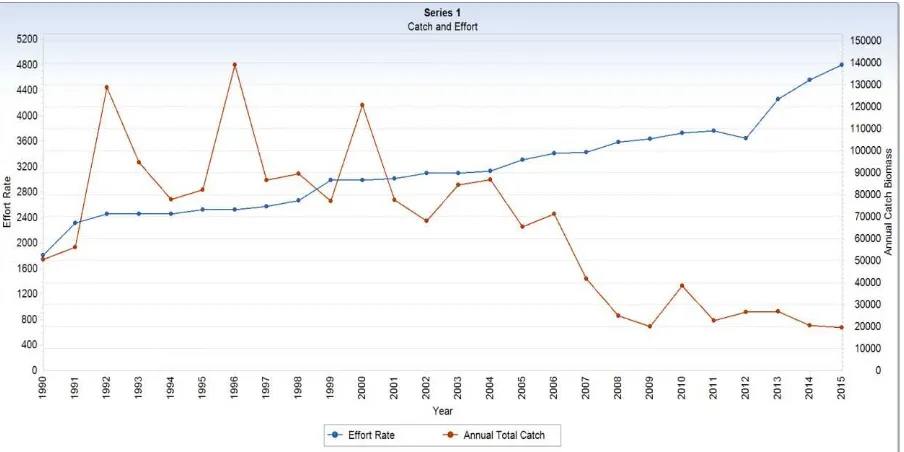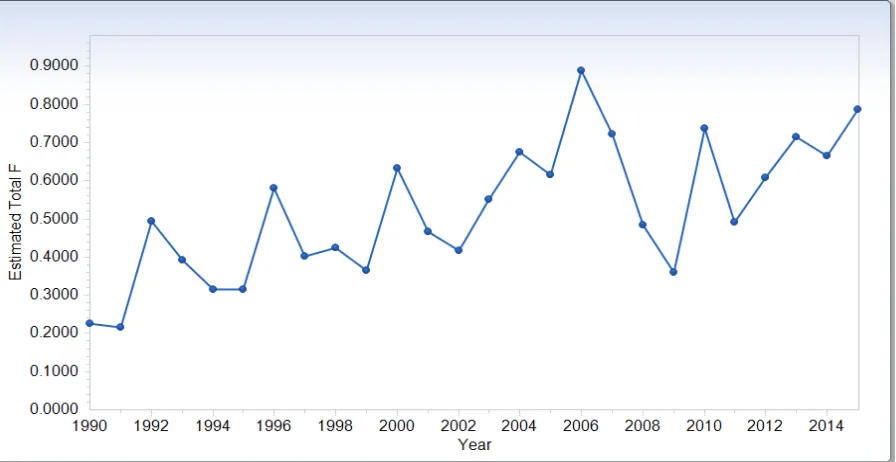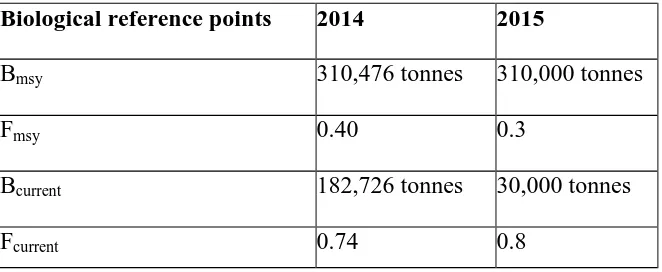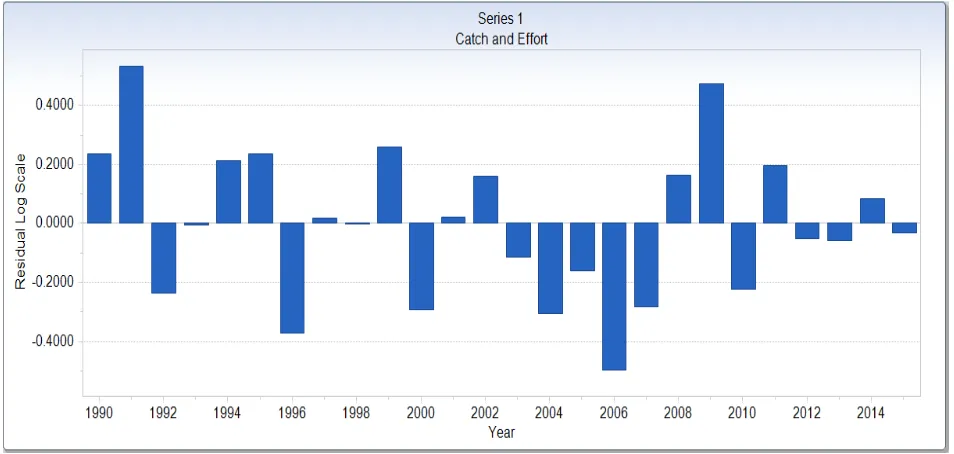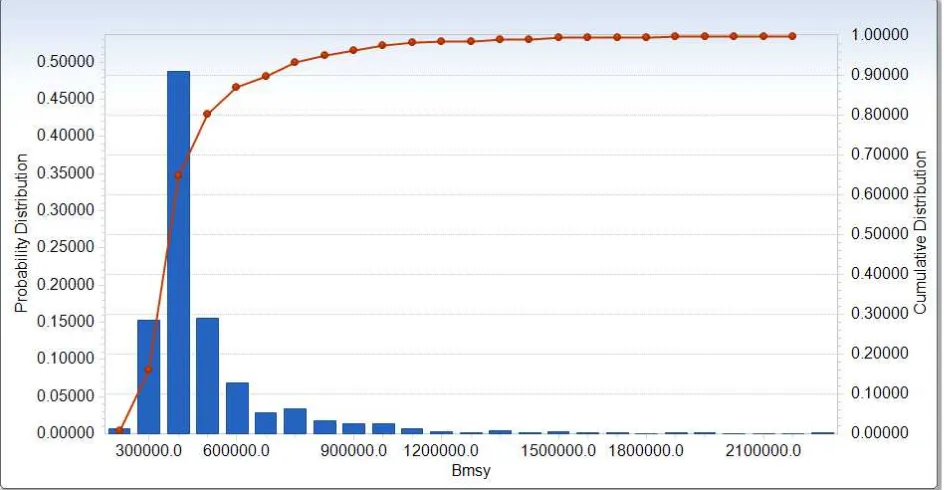SUSTAINABLE FISHERIES
MANAGEMENT PROJECT (SFMP)
Status of the small pelagic stocks in
Ghana - 2016.
This publication is available electronically in the following locations: The Coastal Resources Center
http://www.crc.uri.edu/projects_page/ghanasfmp/
Ghanalinks.org
https://ghanalinks.org/elibrary search term: SFMP USAID Development Clearing House
https://dec.usaid.gov/dec/content/search.aspx search term: Ghana SFMP
For more information on the Ghana Sustainable Fisheries Management Project, contact: USAID/Ghana Sustainable Fisheries Management Project
Coastal Resources Center
Graduate School of Oceanography University of Rhode Island
220 South Ferry Rd.
Narragansett, RI 02882 USA
Tel: 401-874-6224 Fax: 401-874-6920 Email: [email protected]
Citation: Lazar, N., Yankson K., Blay, J., Ofori-Danson, P., Markwei, P., Agbogah, K., Bannerman, P., Sotor, M., Yamoah, K. K., Bilisini, W. B. (2017). Status of the small pelagic stocks in Ghana - 2016. Scientific and Technical Working Group. USAID/Ghana Sustainable Fisheries Management Project (SFMP). Coastal Resources Center, Graduate School of Oceanography, University of Rhode Island. GH2014_ACT150_CRC. 16 pp.
Authority/Disclaimer:
Prepared for USAID/Ghana under Cooperative Agreement (AID-641-A-15-00001), awarded on October 22, 2014 to the University of Rhode Island, and entitled the USAID/Ghana Sustainable Fisheries Management Project (SFMP).
This document is made possible by the support of the American People through the United States Agency for International Development (USAID). The views expressed and opinions contained in this report are those of the SFMP team and are not intended as statements of policy of either USAID or the cooperating organizations. As such, the contents of this report are the sole responsibility of the SFMP team and do not necessarily reflect the views of USAID or the United States Government.
Detailed Partner Contact Information:
USAID/Ghana Sustainable Fisheries Management Project (SFMP) 10 Obodai St., Mempeasem, East Legon, Accra, Ghana
Telephone: +233 0302 542497 Fax: +233 0302 542498
Maurice Knight Chief of Party [email protected]
Kofi Agbogah Senior Fisheries Advisor [email protected] Nii Odenkey Abbey Communications Officer [email protected]
Bakari Nyari Monitoring and Evaluation Specialist [email protected] Brian Crawford Project Manager, CRC [email protected]
Justice Odoi USAID Administrative Officer Representative [email protected] Kofi.Agbogah #3 Third Nautical Close,
Nungua, Accra, Ghana
[email protected] Daasgift Quality Foundation
Headmaster residence, Sekondi College Sekondi, Western Region, Ghana 233 243 326 178
For additional information on partner activities:
CRC/URI: http://www.crc.uri.edu
CEWEFIA: http://cewefia.weebly.com/
DAA: http://womenthrive.org/development-action-association-daa Daasgift:
ACRONYMS
CCM Centre for Coastal Management
CECAF Fishery Committee for the Eastern Central Atlantic CPUE Catch Per Unit Effort
EEZ Exclusive Economic Zone
FAO United Nations Food and Agriculture Organization FC Fisheries Commission
FSSD Fisheries Scientific and Survey Division
ICCAT International Commission for the Conservation of Atlantic Tunas MOFAD Ministry of Fisheries and Aquaculture Development
MSY Maximum Sustainable Yield
TABLE OF CONTENTS
SMALL PELAGIC FISH STOCKS ... 1
STOCK UNIT DEFINITION ... 2
ANNEX 1 MODEL DIAGNOSTICS ... 10
LIST OF FIGURES
Figure 1 Total Landings of small pelagic stocks (Sardinella, Anchovies and Mackerel) in red and effort in number of canoes targeting small pelagics from 1990 to 2015 in Ghana ... 3Figure 2 Biomass trends of small pelagic fish stocks (Sardinella, Anchovies and Mackerel) in metric tons from 1990 to 2015 in Ghana. ... 7
Figure 3 Trends of Fishing Mortality of small pelagic stocks (Sardinella, Anchovies and Mackerel) from 1990 to 2015 in Ghana. ... 7
Figure 4 Production model residuals over the time series 1990 – 2015. ... 10
Figure 5 Bootstrap distribution of 1000 trials of estimates of Fishing Mortality at the Maximum Sustainable Yield (Fmsy = 0.30) ... 11
Figure 6 Bootstrap distribution of 1000 trials of estimates of Biomass at the Maximum Sustainable Yield (Bmsy = 310,000 metric tons = rebuilding target) ... 11
LIST OF TABLES
Table 1 Results of the interviews with fishermen for CPUE calibration for small pelagics in Ghana ... 3INTRODUCTION
This report provides an update of the status of the small pelagic fish stocks in Ghana through 2016. It was led by the Scientific and Technical Working Group (STWG) of the USAID/ Sustainable Fisheries Management Project (SFMP). The information contained here was obtained from the Fisheries Scientific and Survey Division (FSSD) of the Fisheries Commission (FC) of Ghana and other available information. The fish stock assessment was reviewed by the STWG in January 2017.
In this report we use the best scientific available information to show the status of the stock in Ghana. Although small pelagic stocks extend beyond the borders of Ghana’s EEZ we consider, for management purposes only, that the landings from Ghana form a single small pelagic stock. We recognize that this assumption is not true, however since the landings of Ghana represent a large share in the region of the Gulf of Guinea, the status of the stock will be indicative for the rest of the stock outside its boundaries.
This assessment establishes new biological and management indicators or reference points for the purpose of monitoring the status of the stock with impact of fisheries management
actions. However, the STWG recommends maintaining the initial biological references points on biomass (B) and fishing mortality rates (F) estimated in 2015. (See Lazar, N, Yankson K, Blay J., Ofori-Danson P., Markwei P., Agbogah K., Bannerman P., Sotor M., Yamoa K. K., Bilisini W. B., 2017).
The trends of declining fish stocks continue to be a major concern for fisheries
stakeholders in Ghana. The rapid development of coastal pelagic fisheries over the past four decades is at the center of this decline. The biomass of many small pelagic stocks has drastically fallen at alarming rates due primarily to overfishing and overcapacity. Fishing pressure is driven largely by the artisanal fleet operating under open access rules using bigger and more efficient fishing gear and technologies. The average purse seine size is about 800 m today as opposed to 275 m in 1970s. The capacity of canoes increased by 2.5 fold (2 tons to 5 tons). CPUE continues to decline as biomass becomes depleted and the cost of a fishing trip increases as time at sea and fuel consumption increase. Small pelagic species have usually low commercial value but they provide an important source of protein for the coastal population.
The 2015 stock assessments were performed using a surplus production model using non-equilibrium and dynamic approach (see Lazar et al.,2017). The effort data series were not calibrated and measured by direct observations of the number of purse seine canoes. These data driven models are often criticized for lack of the ability of measure changes in
catchability (lack of measuring the changes in efficiency over time). In this report we provide a new approach to model configuration by calibrating the effort using information obtained from a semi-structured survey conducted by Hen Mpoano along the coast. The survey uses local knowledge by experienced fishermen to reconstruct historical perspectives about fishing units (size of the canoe, size of the net, crew size, outboard motor HP…etc.). (Lazar N., Asare C., Nortey D. D. N., Kankam S., & Agbogah K., . 2016).
SMALL PELAGIC FISH STOCKS
al, 2017). They have common biological and ecological traits and are processed and consumed dried or smoked.
STOCK UNIT DEFINITION
Small pelagic species caught in southern Fishery Committee for the Eastern Central Atlantic CECAF region from Guinea to Angola are not known to have distinct biological
differentiation of more than one stock. However, for management purposes and in the absence of information on stock identification, the FAO/CECAF scientific Working Group considers the existence of four stocks of small pelagics in the southern CECAF area:
• Northern zone (Guinea-Bissau, Guinea, Sierra Leone and Liberia).
• Western zone (Côte d’Ivoire, Togo, Ghana, Togo and Benin).
• Central zone (Nigeria and Cameroon).
• Southern zone (Gabon, the Democratic Republic of the Congo, the Congo and Angola) areas.
We define a sub-unit within the south Western stock represented by Ghana’s fisheries and indicative of the entire stock.
DATA SOURCES
Landings and effort
The artisanal purse seine and beach seines are the main fishing gear used in exploiting the small pelagic resources. There are two types of artisanal purse seine gear, and the difference is in the mesh size. The purse seine with a 25 mm mesh is locally called “watsa” while the one with a 10mm mesh is called “poli”. The beach seine has a mesh size of 10 mm and is common in Volta and Western Region, mainly along estuaries. The purse seine and encircling gillnets are operated from canoes ranging between 10 to 20 meters. There are over 3000 artisanal purse seine canoes and 900 beach seine canoes operating along the entire coast.
Total Landings have been in sharp decline since 2000, reaching their lowest level in 2015 at 19,608 tonnes (Figure 1). This represents 14% of the highest recorded landings of 1996 (138,955 tonnes). The average zero catch (vessel spending more than 20 hours searching for fish and returning with no catch) has increased. Preliminary estimates shows more than 25% of vessels in Tema returned to harbor without catch. (Personal communication).
The rapid declining trends of small pelagic landings do immediately suggest that there is a serious overfishing situation in Ghana’s small pelagic fisheries. The presence of smaller sizes in the catch is noticeable in almost every landings site due to the use of smaller mesh sizes averaging 0.5 cm.
Figure 1 Total Landings of small pelagic stocks (Sardinella, Anchovies and Mackerel) in red and effort in number of canoes targeting small pelagics from 1990 to 2015 in Ghana
In addition the increased net size overtime demanded an increase in number of man-power to operate the nets, resulting in a significant increase in efficiency per unit of effort by 55% over 4 decades (Table 1).
Table 1 Results of the interviews with fishermen for CPUE calibration for small pelagics in Ghana
1970-1980 1980-1990 1990-2000 Present
Fishing units 2 2 2 2
represented by a calibrated effort based on the number of canoes and no auxiliary estimates of abundance using acoustic surveys. The model is a mass balance approach in which stock biomass each year is the biomass the year before plus new production minus the catch removed. New production is the net difference between additions from growth and
recruitment and mortality losses. The stock growth is assumed to follow the familiar logistic curve.
Where: t = year
Bt+1 = population biomass of next year (t+1)
Bt = population biomass of this year (t) r = intrinsic rate of increase in biomass
ϵ
= lognormal process errorThe (r) parameter is a measure of population growth rate at very low abundance when density dependent factors are inoperative. The term in parenthesis is the density dependent feedback mechanism that reduces stock growth when abundance is high. To connect the catch rates of biomass (B) via a catchability coefficient (proportion of the total stock taken by one unit of effort) represented by (q). The relationship between the catchability q and the CPUE is:
Where:
q = catchability coefficient
CPUE = Catch-Per-Unit of Effort
The model is then fit iteratively by minimizing the sum of square residuals between observed CPUE and predicted CPUE in the form of:
Where CPUE, representing an Index of abundance (I), is the observed rate from which to subtract the predicted or expected CPUE from the model.
The management quantities for sustainable fisheries can be derived from the logistic model parameters as follows:
Maximum sustainable yield (MSY) is the maximum yield that a stock can deliver year after year over the long term. It is a function of both carrying capacity and stock productivity. In order to produce MSY, a stock needs to be at a biomass level equal to one-half carrying capacity (Bmsy) and be subject to a fishery removal rate no greater than Fmsy. The latter is equal to one-half the maximum rate of stock growth. A fishing mortality rate that
approaches the maximum rate of stock growth will lead to stock collapse (Fcoll). Fishing Effort Calibration
Where CPUEobserved(i) is the raw number of canoes targeting small pelagics estimated by the frame surveys over the period from 1990-2016; CPUEcorrected(i) is the corrected index for
period of years i and α is the annual rate of increase of fishing power of the artisanal canoe fishery.
The increase in efficiency is linked in modernization of the canoes, increased horse power of outboard engines, increase in net size. The use of light fishing is another factor improving efficiency, however the FSSD report of 2005 demonstrated little evidence of this.
(Bannerman, 2005). Fishermen believe that light fishing is a significant tool for increased fishing efficiency and success. A study to better measure claims of increased efficiency of light fishing could be useful and might result in a revised calibration to improve the fit of the surplus model. .
RESULTS
The model performed well and provided a reasonable level of precision (CV=0.07). Estimated biomass of total small pelagic species in Ghana declined sharply following the trends of landings. Recent levels have reached the lowest point over the period between 1990 and 2015. Biomass in 2015 was estimated at 30,000 tonnes (Figure 2). This represents about 12% of the biomass needed to maintain sustainable exploitation of the stock. The rebuilding target Bmsy was estimated at 310,000 tonnes. The terminal relative biomass (B2015), expressed in a ratio of current biomass divided by Bmsy, was estimated at 0.12.
The status of the small pelagic fish stocks in Ghana are considered severely overfished. Fishing mortality has gradually increased in the past 25 years reaching high and
unsustainable levels in 2015. The Fishing mortality in 2015 was estimated at F=0.8 (Figure 3). The recent Fridjoft Nansen research acoustic survey conducted in April 2016 in the waters of Ghana estimated similar levels of biomass for small pelagic stocks, noting a possible collapse of the sardinella stocks.
The average size of sardinella landed in 1998 was recorded by the Fisheries Scientific and Survey Division at 16 cm. The recent record of the average size was at 9.5 cm in Tema in 2016, focusing mainly on juveniles of less than one year old. Both signs of heavy recruitment and growth overfishing are confirmed by these observations.
For small pelagic fish stocks, we select two types of biological reference points (biological indicators) measuring fishing mortality (F) and biomass (B). The two indicators are Fmsy (sustainable level of harvest) and Bmsy (sustainable biomass level which will be considered restored or rebuilt and one that can produce MSY).
Fmsy is the level of harvest to achieve sustainability in the long term based on growth and reproductive rates. The Fmsy for the small pelagic stocks is estimated by this model at Fmsy = 0.3 compared to the Fmsy = 0.4 estimated using the same production model with
Figure 2 Biomass trends of small pelagic fish stocks (Sardinella, Anchovies and Mackerel) in metric tons from 1990 to 2015 in Ghana.
Figure 3 Trends of Fishing Mortality of small pelagic stocks (Sardinella, Anchovies and Mackerel) from 1990 to 2015 in Ghana.
We note no significant changes in Bmsy, Therefore the rebuilding target of small pelagic stocks remains at 310,476 tonnes.
Table 2 Model estimates of current biomass, fishing mortality rates and management reference points
Biological reference points 2014 2015
Bmsy 310,476 tonnes 310,000 tonnes
Fmsy 0.40 0.3
Bcurrent 182,726 tonnes 30,000 tonnes
Fcurrent 0.74 0.8
The STWG concludes that current fishing effort is well beyond the level of sustainability for the small pelagic stocks. In the absence of effort control measures, stocks will continue to decline with diminishing economic returns leading to further deterioration of social conditions in fishing communities.
It is common for small pelagic species (forage species) to be more prone to rapid collapse than for other types of marine fishes due in part to their rank in the food web and their response to environmental conditions. These fish occupy a very special position in food webs, ensuring energy transfer between species lower and higher levels, while forming a narrow range of species richness. The collapse of the pelagic stocks have a domino effect on both higher and lower trophic species.
RECOMMENDATIONS
The STWG recommends that the Fisheries Commission should end open access and complete the canoe registration and licensing of the small artisanal fisheries.
Short-lived species, such as small pelagics, can grow or decline quickly in response to fishing pressure, and this rapid decline in productivity often requires similarly rapid and drastic interventions by fisheries managers to reverse the trends. Notwithstanding
environmental changes, the small pelagic stocks continue to be driven to collapse, as may already be the case with the round sardinella in Ghana. The STWG presented a proposal to the Fisheries Commission to end overfishing and begin the rebuilding process. ( Lazar, N, Yankson K, Blay J., Ofori-Danson P., Markwei P., Agbogah K., Bannerman P., Sotor M., Yamoa K. K., Bilisini W. B.,2016 )The proposal suggested a closed fishing season for one month for all fleets and all fisheries during the spawning period to allow broodstock to reproduce and for the juveniles to replace the lost biomass. The proposal remains under review and consideration by the Fisheries Commission.
REFERENCES
Bannerman P., Quartey R.(2004) Observations of commercial light fishing operations in Ghana. Report of the Marine Fisheries Research Division (MRFD- Tema – Ghana). http://www.oceandocs.org/bitstream/handle/1834/1266/BANNERMAN%20improve ments%20in%20the%20Ghanaian%20tuna%20statistics%20syste.pdf?sequence=1
Dovlo E., Amador K., Nkrumah B. (2016) Report of the 2016 Ghana marine canoe frame survey. Information report No 26. Fisheries Survey and Statistical Division. 85 pp. Lazar N., Asare C., Nortey D. D. N., Kankam S., & Agbogah K. (2016). The Small Pelagic
Fisheries Profile: Analysis of Regional Results. USAID/Sustainable Fisheries
Management Project (SFMP). Narragansett, RI: Coastal Resources Center, Graduate School of Oceanography, University of Rhode Island and Hen Mpoano.
GH2014_ACT001_CRC. 39 pp.
http://www.crc.uri.edu/download/GH2014_ACT023_HM_FIN508.pdf
Lazar, N, Yankson K, Blay J., Ofori-Danson P., Markwei P., Agbogah K., Bannerman P., Sotor M., Yamoa K. K., Bilisini W. B. (2016) Proposal for closed fishing season for small pelagic fisheries in Ghana. Scientific and Technical Working Group of
USAID/Ghana Sustainable Fisheries Management Project (SFMP). Coastal Resources Center, Graduate School of Oceanography, University of Rhode Island.
GH2014_SCI002_CRC. 17 pp.
http://www.crc.uri.edu/download/GH2014_SCI002_CRC_FIN508.pdf
Lazar, N, Yankson K, Blay J., Ofori-Danson P., Markwei P., Agbogah K., Bannerman P., Sotor M., Yamoa K. K., Bilisini W. B. (2017) Status of the small pelagic stocks in Ghana (2015). Scientific and Technical Working Group of USAID/Ghana Sustainable Fisheries Management Project (SFMP). Coastal Resources Center, Graduate School of Oceanography, University of Rhode Island. GH2014_ACT093_CRC 28 pp. http://www.crc.uri.edu/download/GH2014_ACT093_CRC_FIN508.pdf
ANNEX 1 MODEL DIAGNOSTICS
The surplus production model was run 2000 times involving calibrated CPUE indices, nested in spatial strata and parameter format (constant, blocked and added an environmental factor). The model performance is presented below by a plot of process error residuals of the model in Figure 4. Overall the model with calibrated CPUE performed better than that used without taking into account the changes in fishing performance, including net and boat size and engine power. The data is highly variable but showed no bias in the parameter estimates. Several aspects of small pelagics biology are known to be sensitive to temperature with abundance generally reduced during periods of high water temperatures. The model suggests reduction in productivity and operation of dispensatory mortality at low abundance. A likely mechanism is low intensity of the upwelling indices and a predator-prey relationship forced by overfishing and climate variations.
Figure 4 Production model residuals over the time series 1990 – 2015.
The error is normal, high in 1991, 2006 and 2009 but no sign of consistent bias.
Figure 5 Bootstrap distribution of 1000 trials of estimates of Fishing Mortality at the Maximum Sustainable Yield (Fmsy = 0.30)
